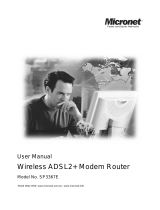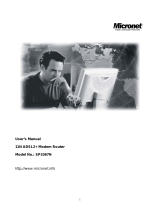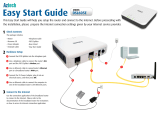Page is loading ...

Micronet
R
Faster and Easier Networks
User Manual
Wireless ADSL2+ Modem Router
Model No. SP3367A
http://www.micronet.info

1
CE Declaration of conformity
This equipment complies with the requirements relating to electromagnetic
compatibility, EN55022 class A for ITE, the essential protection
requirement of Council Directive 89/336/EEC on the approximation of the
laws of the Member States relating to electromagnetic compatibility.
FCC Part 68
This equipment complies with Part 68 of the FCC Rules. On the bottom of
this equipment is a label that contains the FCC Registration Number and
Ringer Equivalence Number (REN) for this equipment. You must provide
this information to the telephone company upon request.
The REN is useful to determine the quantity of devices you may connect to
the telephone line and still have all of those devices ring when your
number is called. In most, but not all areas, the sum of the REN of all
devices connected to one line should not exceed five (5.0). To be certain of
the number of devices you may connect to your line, as determined by the
REN, you should contact your local telephone company to determine the
maximum REN for your calling area.
If the modem causes harm to the telephone network, the telephone
company may discontinue your service temporarily. If possible, they will
notify you in advance. But if advance notice isn't practical, you will be
notified as soon as possible. You will be advised of your right to file a
complaint with the FCC.

2
The telephone company may make changes in its facilities, equipment,
operations, or procedures that could affect the proper operation of your
equipment. If they do, you will be notified in advance to give you an
opportunity to maintain uninterrupted telephone service.
If you experience trouble with this modem, please contact your dealer for
repair/warranty information. The telephone company may ask you to
disconnect this equipment from the network until the problem has been
corrected or you are sure that the equipment is not malfunctioning.
This equipment may not be used on coin service provided by the
telephone company. Connection to party lines is subject to state tariffs.
Installation
This device is equipped with a USOC RJ11C connector.
FCC Part 15
The modem generates and uses radio frequency energy. If it is not
installed and used properly in strict accordance with the user's manual, it
may cause interference with radio and television reception. The modem
has been tested and found to comply with the limits for Class B computing
devices in accordance with the specifications in Subpart B, Part 15 of the
FCC regulations. These specifications are designed to provide reasonable
protection against such interference in a residential installation. However,
there is no guarantee that interference will not occur in a particular

3
installation. FCC regulations require that shielded interface cables be used
with your modem.
If interference does occur, we suggest the following measures be taken to
rectify the problem:
1) Move the receiving antenna.
2) Move the modem away from the radio or TV.
3) Plug the modem into a different electrical outlet.
4) Discuss the problem with a qualified radio / TV technician.
CAUTION:
Changes or modifications not expressly approved by the party responsible
for compliance to the FCC Rules could void the user's authority to operate
this equipment.
Cable connections:
All equipment connected to this modem must use shielded cable as the
interconnection means.
Notes:
Operation is subject to the following two conditions:
1) This device may not cause harmful interference, and
2) This device must accept any interference received including
interference that may cause undesired operation.

4
Contents
CE Declaration of conformity......................................................................1
Chapter 1 Introduction..............................................................................6
1.1 Overview........................................................................................6
1.2 Features ........................................................................................7
1.3 System Requirements...................................................................9
Chapter 2 Installation.............................................................................10
2.1 Checklist......................................................................................10
2.2 The Front LEDs ...........................................................................11
2.3 The Rear Ports ............................................................................12
2.4 Hardware installation...................................................................13
2.5 Splitter Configuration...................................................................14
POTS Splitter Configuration (ADSL over POTS) .......................14
ISDN Splitter Configuration (ADSL over ISDN)..........................16
Chapter 3 Connection............................................................................17
3.1 Determine connection settings....................................................17
3.2 Connecting the Router to network...............................................17
3.3 The relative configuration on PC.................................................17
Chapter 4 Configuration.........................................................................20
4.1 Access the Modem Router ..........................................................20
4.2 Quick Setup.................................................................................21
4.3 Interface Setup............................................................................25
4.3.1 Internet..............................................................................25
4.3.2 LAN Configuration.............................................................31
4.3.3 Wireless Settings...............................................................33
4.4 Advanced Setup ..........................................................................35

5
4.4.1 Routing Table ....................................................................35
4.4.2 NAT Setting.......................................................................37
4.4.3 ADSL.................................................................................40
4.4.4 Firewall..............................................................................41
4.5 Access Management...................................................................42
4.5.1 ACL....................................................................................42
4.5.2 IP Filtering.........................................................................43
4.5.2 SNMP................................................................................44
4.5.3 UPnP.................................................................................45
4.5.4 DDNS................................................................................46
4.6 Maintenance................................................................................47
4.6.1 Administration....................................................................47
4.6.2 Time Zone .........................................................................48
4.6.3 Firmware Update...............................................................49
4.6.4 System Restart..................................................................50
4.6.5 Diagnostic..........................................................................51
4.7 Status...........................................................................................52
4.7.1 Device Info ........................................................................52
4.7.2 System Log .......................................................................54
4.7.3 ADSL Statistics..................................................................55
Chapter 5 Troubleshooting.....................................................................56
Appendix A Glossary..............................................................................61
Appendix B Cabling................................................................................68
Appendix C Service / Port......................................................................69

6
Chapter 1 Introduction
The ADSL2+ Router provides home connectivity to an ADSL service
provider network over an ADSL/ Asynchronous Transfer Mode (ATM)
physical layer. The router can run upstream maximum transmission rates
of 2Mbps and downstream maximum transmission rates of 24Mbps. The
actual rate depends on the copper category of your telephone wire,
distance from the central office and the type of ADSL2+ service
subscribed. Four ports switch is provided for connection to an Ethernet
LAN or Ethernet-equipped PC and this router is easy to install and to
configure.
1.1 Overview
The ADSL2+ wireless Router is optimized to address the growing demand
for high-speed Internet access and it does so as a single, highly-integrated
and cost-effective solution.

7
1.2 Features
ADSL2/2+ Compliance
♦ Compliant with ADSL standards
♦ Full-rate ANSI.413 Issue 2 , ITU G.dmt (G.992.1) , G.dmt bis (G.992.3)
and G.adslplus(G.992.5) standards
Splitter less ITU G.lite (G.992.2) specification
Annex A (ADSL over POTS) and Annex B (ADSL over ISDN), compliant
to ETSI TS 101 388
♦ DMT modulation and demodulation
♦ Full-rate adaptive modem
Maximum downstream rate of 24 Mbps
Maximum upstream rate of 2 Mbps
♦ Tone detection for low power mode
♦ Supports splitter less ADSL implementation
♦ Interoperable with all major DSLAM equipment
ATM Protocols
♦ WAN mode support: PPP over ATM (RFC 2364) and PPP over Ethernet
(RFC 2516)
♦ LAN mode support: bridged/routed Ethernet over ATM (RFC 2684) and
classical IP over ATM (RFC 1577)
♦ Up to 8 VCs (virtual circuits)
♦ ATM SAR (segmentation and reassembly)
♦ ATM AALC (adaption layer type 5)

8
Bridge Mode
♦ Ethernet to ADSL self learning Transparent Bridging (IEEE 802.1D)
♦ Supports MAC learning addresses
Router Mode
♦ IP routing-RIPv2
♦ Static routing
♦ DNS Proxy
♦ Dynamic DNS
♦ DMZ
♦ Port Forwarding
♦ DHCP (dynamic host configuration protocol) server and client
♦ NAT (network address translation)
♦ ICMP (Internet control message protocol)
Wireless Features
♦ Support 802.11b/g Wireless Access Point
♦ Support shared 128-Bit and 64-Bit WEP encryption, WPA-PSK
Security
♦ Stateful packet inspection and filtering
♦ Intrusion detection and protection
♦ PAP (password authentication protocol)
♦ CHAP (challenge authentication protocol)
♦ Password protected system management

9
Ethernet Interface
♦ Compliant with IEEE 802.3 and 802.3u 10/100 Mbps
HTTP Web-Based Management
♦ Firmware upgrade by UI
♦ Customizable Web pages
♦ WAN and LAN side connection statistics
♦ Configuration of static routes and routing table
♦ Password protected access
♦ Wireless Lan
♦ System log
♦ Configuration of VCs (virtual circuits)
1.3 System Requirements
♦ Personal computer (PC)
♦ Pentium II 233 MHz processor minimum
♦ 32 MB RAM minimum
♦ 20 MB of free disk space minimum
♦ Ethernet Network Interface Controller (NIC) RJ45 Port
♦ Internet Browser

10
Chapter 2 Installation
This chapter offers information about installing your router. If you are not
familiar with the hardware or software parameters presented here, please
consult your service provider for the values needed.
2.1 Checklist
Check the shipping box carefully to ensure that the contents include the
items you ordered. If any of the items are missing or damaged, contact
your local distributor.
Contents description
♦ 54M Wireless ADSL2+ Modem Router
♦ Quick Installation Guide
♦ User manual CD
♦ ADSL RJ-11 telephone cable
♦ Ethernet RJ-45 cable
♦ Power adapter

11
2.2 The Front LEDs
LED State Description
PWR ON
When the router power on
Off
When wireless AP is disabled
WLAN
Blinking
While wireless traffic is transmitting or
receiving
On
Connected to an ADSL DSLAM successfully
ADSL
Blinking
No connection
On
The LAN cable is connected to the router
Off
No network connection
LAN
LINK/ ACT
(Port 1 - 4)
Blinking
Network traffic transferring or receiving
through the LAN port

12
2.3 The Rear Ports
Connector Description
Antenna
Connector
Reverse SMA connector
Reset
The reset button, the router restore default
settings when press until reboot
POWER
Power connector with 12VDC/ 1 Ampere
LAN (1-4)
Router is successfully connected to a device
through the corresponding port (1, 2, 3 or 4). If
the LED is flashing, the Router is actively
sending or receiving data over that port.
ADSL
The RJ-11 connector allows data communication
between the modem and the ADSL network
through a twisted-pair phone wire

13
2.4 Hardware installation
This section describes how to connect and configure the ADSL router.
1) Connect the ADSL line
Connect the router directly to the wall jack using the included ADSL
RJ-11 telephone cable.
2) Connect a workstation to the Router's LAN port
Use Ethernet RJ-45 cable to connect computer or expend Ethernet
network.
3) Connect the power adapter to the Router
Connect the power adapter to the port labeled POWER on the rear
panel of router.
4) Connect all cables to the Network
The procedure for connecting cables differs depending on whether or
not your telephone equipment is connected to a POTS splitter. The next
section explains ADSL splitter and describes the configuration in
networks of ADSL over POTS and ADSL over ISDN.

14
2.5 Splitter Configuration
ADSL splitter builds-on a micro-filter it stops the ADSL signal interfering
with the voice part of your phone line. The graph hereunder shows the
frequency range that your phone (POTS) and ADSL occupy. Use ADSL
splitter to separate the bands for POTS and ADSL and get better
communication quality.
POTS Splitter Configuration (ADSL over POTS)
A POTS splitter separates data signals from voice signals on your
telephone line. The POTS splitter works by running a separate data line
from the voice line, so that the ADSL router has a cable dedicated for data
transmission. Figure 2-5.1 and 2-5.2 shows how to connect all cables to
the Router.

15
Figure 2-5.1 Router connected through a POTS Splitter
Note: The POTS splitter may also be installed on the outside of the house
adjacent to the telephone network interface device (NID).
Figure 2-5.2 Router connected through several micro-filters

16
ISDN Splitter Configuration (ADSL over ISDN)
A ISDN splitter separates ADSL signals from ISDN signals on your ISDN
telephone line. The ISDN splitter works by running a separate ADSL line
from the ISDN line, so that the ADSL router has a cable dedicated for data
transmission. Figure 2-5.3 shows how to connect all cables to the Router.
Figure 2-5.3 Router Connected through a ISDN Splitter
Note: The ISDN splitter may also be installed on the outside of the house
adjacent to the telephone network interface device (NID).

17
Chapter 3 Connection
3.1 Determine connection settings
Before configure the router, you need to know the connection information
supplied by your ADSL service provider.
3.2 Connecting the Router to network
Unlike a simple hub or switch, the setup of the ADSL Router consists of
more than simply plugging everything together. Because the Router acts
as a DHCP server, you will have to set some values within the Router and
also configure your networked PCs to accept the IP Addresses the Router
chooses to assign to them. Generally, there are several different operating
modes for your applications. Your ISP will tell you which mode is
necessary for your system. The modes available are router, bridge,
PPPoE+NAT and PPPoA+NAT.
3.3 The relative configuration on PC
Please follow the steps instructed below when installing your system for
the first time via web console:
1) Shut down the power on everything, including your PCs and ADSL
Router.

18
2) Connect a network cable from one of your PCs' Ethernet ports to the
LAN port on the back of the Router.
3) Connect the power adapter to the Power port on the rear of the Router
then connect to a power outlet using the power cord included in the
Router's packaging.
4) Power on one of your PCs. Click the Start button, select Settings and
then select Control Panel.
5) Double-click the Network icon.
6) In the Configuration window, highlight the TCP/IP that has been
associated with your network card or adapter. (Do NOT configure
TCP/IP Dial-up Adapter.) Click Properties. If the TCP/IP Protocol isn't
listed in the Configuration window, install it.
7) Click the IP Address tab. Select “Obtain an IP address automatically”.
Click OK.

19
8) Click OK again. Windows may begin copying files to your computer. (In
Windows 98, system will ask you to restart your PC. Click Yes to restart
your computer and initiate the new settings.)
/



